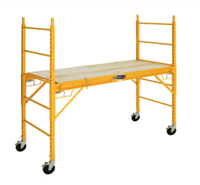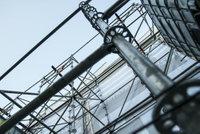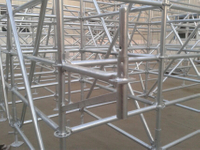Content Menu
● Introduction to Cuplock Scaffolding
● Components of Cuplock Scaffolding
● Standard Material for Cuplock Scaffolding
>> Steel Grades Used
>> Surface Treatment
● Benefits of Cuplock Scaffolding Material
● Safety Considerations for Cuplock Scaffolding Material
● Choosing the Right Cuplock Scaffolding Material
>> Evaluating Manufacturing Experience
>> Importance of Certifications
>> Role of Customer Service
● Applications of Cuplock Scaffolding Material
● Conclusion
● FAQ
>> 1. What is the standard diameter and thickness of cuplock scaffolding pipes?
>> 2. What are the common steel grades used for cuplock scaffolding?
>> 3. How does the cuplock scaffolding system enhance safety?
>> 4. What is the typical surface treatment for cuplock scaffolding?
>> 5. What are the benefits of using cuplock scaffolding over traditional systems?
● Citations:
Cuplock scaffolding is a widely used modular steel scaffolding system in construction, maintenance, and other industries due to its efficiency and safety features. The standard material for cuplock scaffolding is high-quality steel, specifically designed to provide strength and durability. In this article, we will explore the standard materials used for cuplock scaffolding and provide insights into its components and applications.
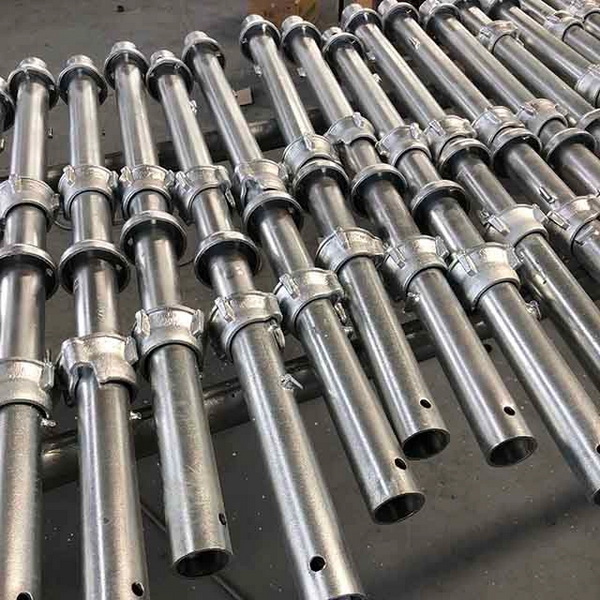
Introduction to Cuplock Scaffolding
Cuplock scaffolding is known for its unique node-point locking device, which allows for the connection of multiple horizontal scaffolds with ease. This system is composed of standards, ledgers, braces, and planks, making it versatile for various construction needs.
Components of Cuplock Scaffolding
- Standards: These are the vertical components of the scaffolding system, typically made from 48.3mm diameter pipes with a thickness of 3.2mm or 4.0mm. They are equipped with top and bottom cups for connecting ledgers and braces.
- Ledgers: These are horizontal components that connect to the standards using the cup-node system. They also have a diameter of 48.3mm and a thickness of 3.2mm.
- Braces: Diagonal braces provide additional stability to the structure. They are typically made from 48.3mm diameter pipes with a thickness of 2.5mm.
Standard Material for Cuplock Scaffolding
The standard material for cuplock scaffolding is high-quality steel, often in grades such as S355 or Q355, which offer high yield and tensile strength. The pipes used are typically 48.3mm in diameter with a thickness of 3.2mm or 4.0mm for higher load capacities.
Steel Grades Used
- S355 (or Q355): This is a high-strength steel grade commonly used for cuplock scaffolding, providing excellent durability and load-bearing capacity.
- S235: This grade is also used but offers lower strength compared to S355.
Surface Treatment
- Hot-Dip Galvanized: This is the most common surface treatment for cuplock scaffolding, providing a durable and corrosion-resistant finish.
- Painted/Powder Coated: Some manufacturers also offer painted or powder-coated finishes, though these are less common.
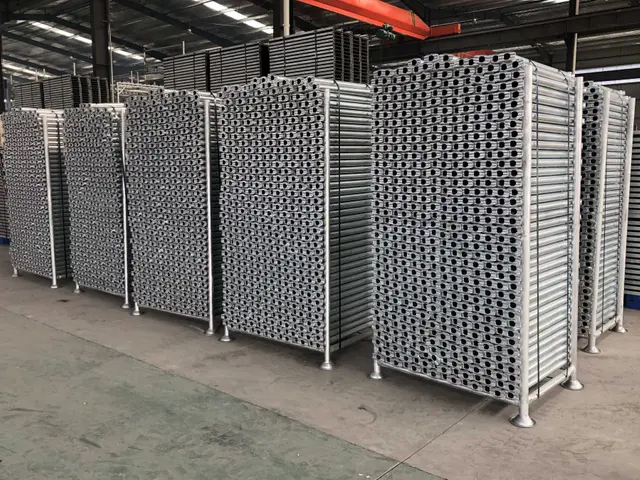
Benefits of Cuplock Scaffolding Material
Cuplock scaffolding material offers several benefits:
- Lightweight and Portable: Cuplock scaffolding is 20% lighter than traditional scaffolding, making it easier to transport and handle on-site.
- Efficient Assembly: The cuplock system allows for quick and easy assembly, saving up to 50% of construction time compared to traditional systems.
- Versatility: Cuplock scaffolding can be adapted to various configurations, making it suitable for a wide range of applications, including facade scaffolding, formwork support, and mobile scaffolding.
Safety Considerations for Cuplock Scaffolding Material
Safety is paramount when using cuplock scaffolding. Here are some key considerations:
- Regular Inspections: Regularly inspect the scaffolding for any damage or wear to ensure it remains safe for use.
- Proper Assembly: Ensure that the scaffolding is assembled correctly according to the manufacturer's instructions.
- Training: Ensure that all personnel using the scaffolding are properly trained.
Choosing the Right Cuplock Scaffolding Material
When selecting cuplock scaffolding material, consider the following factors:
1. Quality of Materials: Ensure the material is made from high-quality steel that meets international standards such as EN 12810.
2. Manufacturing Experience: Look for manufacturers with extensive experience in producing cuplock scaffolding systems.
3. Certifications and Compliance: Check if the manufacturer complies with relevant safety standards and has necessary certifications.
4. Customer Service and Support: Good customer service is crucial for addressing any issues or queries you may have.
5. Price and Value: While cost is important, prioritize quality and reliability over the lowest price.
Evaluating Manufacturing Experience
Manufacturing experience is a key factor in ensuring that the scaffolding material is produced with precision and consistency. Experienced manufacturers are more likely to have refined their production processes, reducing the likelihood of defects and improving overall quality.
Importance of Certifications
Certifications such as ISO 9001 for quality management and ISO 14001 for environmental management demonstrate a manufacturer's commitment to maintaining high standards. Additionally, compliance with safety standards like EN 12810 ensures that the scaffolding meets rigorous safety requirements.
Role of Customer Service
Effective customer service can make a significant difference in your experience with a manufacturer. It ensures that any issues with the scaffolding material can be addressed promptly, minimizing downtime and ensuring projects stay on schedule.
Applications of Cuplock Scaffolding Material
Cuplock scaffolding material is versatile and can be used in a variety of applications:
- Facade Scaffolding: Ideal for exterior work on buildings, providing a stable platform for painting, repairs, or renovations.
- Formwork Support: Used to support concrete formwork during construction, ensuring that the structure remains stable until the concrete sets.
- Mobile Scaffolding: Designed for easy movement around the construction site, allowing workers to access different areas efficiently.
Conclusion
Cuplock scaffolding material is renowned for its strength, durability, and versatility, making it a preferred choice in the construction industry. By understanding the standard materials used and the benefits they offer, you can ensure that your scaffolding is both safe and efficient. Additionally, selecting a reliable manufacturer is crucial to maintaining high-quality standards.

FAQ
1. What is the standard diameter and thickness of cuplock scaffolding pipes?
Cuplock scaffolding pipes typically have a diameter of 48.3mm and a thickness of 3.2mm or 4.0mm for higher load capacities.
2. What are the common steel grades used for cuplock scaffolding?
The most common steel grades used are S355 (or Q355) for high strength and S235 for lower strength applications.
3. How does the cuplock scaffolding system enhance safety?
The cuplock system enhances safety by allowing up to four horizontals to be securely locked into place with a single hammer stroke, eliminating loose clips or bolts.
4. What is the typical surface treatment for cuplock scaffolding?
The typical surface treatment is hot-dip galvanizing, which provides a durable and corrosion-resistant finish.
5. What are the benefits of using cuplock scaffolding over traditional systems?
Cuplock scaffolding is lighter, easier to erect, and offers faster construction times compared to traditional systems.
Citations:
[1] https://www.wm-scaffold.com/cuplock-scaffolding-standard.html
[2] https://www.wm-scaffold.com/steel-scaffolding-grades/
[3] https://rapid-scafform.com/cuplock-scaffold/
[4] https://www.wm-scaffold.com/cup-lock-scaffold.html
[5] https://wslindia.com/scaffolding-system/cuplock/
[6] https://jumplyscaffolding.com/what-is-cuplock-scaffolding/
[7] https://aaitscaffold.com/blog/cuplock-scaffolding-types-uses-benefits-and-safety/
[8] https://metecmetal.en.made-in-china.com/product/ZCBJHeOxfrVP/China-Galvanized-Steel-Scaffold-Cuplock-Standard.html
[9] https://www.rscaffolding.com/product-detail/cuplock-scaffolding-standards/













